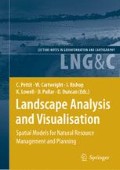Abstract
Place is a complex concept. We might limit our thinking to a pair of geographic coordinates or we may seek to understand how a place came to be, what processes are happing in it now, or what options exist for its future. To really know a place we should be aware of all these aspects. Some people, based on prior training or life experience, have an ability to ‘read’ places and immediately understand the geological forces, erosion processes, ecological succession, human activities and climatic constraints which together define character and provide opportunities. Others are not so blessed, and yet agreement on purpose depends upon this prior understanding. Therefore, to reach consensus on land management and policy drivers, we require tools which help all stakeholders to understand what makes a place the way it is and what changes are sustainable. This paper presents recent and ongoing work in environmental visualisation and other tools, such as agent-based modelling, and reviews their demonstrated and potential contribution to understanding and agreement. In particular, work which automates the creation of landscape models, links these to environmental-process simulators for scenario testing, and makes these available as collaborative virtual places is illustrated.
Access this chapter
Tax calculation will be finalised at checkout
Purchases are for personal use only
Preview
Unable to display preview. Download preview PDF.
References
Agnew J (1987) Place and politics. Allen and Unwin, Boston
Appleton K, Lovett A (2003) GIS-based visualisation of rural landscapes: defining ‘sufficient’ realism for environmental decision-making. Landscape and Urban Planning 65(3):117–131.
Bergen RD, Ulricht CA, Fridley JL, Ganter MA (1995) The validity of computergenerated graphic images of forest landscape. Journal of Environmental Psychology 15(2):135–146
Bishop ID (2001) Predicting movement choices in virtual environments. Landscape and Urban Planning 56(3–4):97–106
Bishop ID, Leahy PNA (1989) Assessing the visual impact of development proposals: the validity of computer simulations. Landscape Journal 8:92–100
Champion E, Dave B, Bishop I (2003) Interaction, agency and artifacts. digital design: research and practice. In: Proceedings of the 10th International Conference on Computer Aided Architectural Design Futures, Taiwan. Kluwer Academic Publishers, Norwell, Masachusetts, pp 249–258
Chen T, Stock C, Bishop ID, O’Connor A (2006) Prototyping an in-field collaborative environment for landscape decision support by linking GIS with a game engine. Paper presented at Geoinformation, Wuhan, China, 28–29 October 2006
Cresswell T (2004) Place: a short introduction. Blackwell Publishing, Malden
Pettit C, Cartwright WE, Bishop ID, Park G, Ridley A, Kemp O (2007) eFarmer – a web based farm management and catchment planning tool. Paper accepted for International Congress on Modelling and Simulation, 10–13 December 2007, Christchurch, New Zealand
Spottiswood L, Bishop ID (2005) An agent-driven virtual environment for the simulation of land use decision making. Paper presented at International Congress on Modelling and Simulation, 12–15 December 2005, Melbourne, Australia
Stock C, Bishop ID, O’Connor A (in press) SIEVE: collaborative decision-making in an immersive online environment. Cartography and Geographic Information Science
Tuan YF (1977). Space and place: the perspective of experience. University of Minnesota Press, Minneapolis
Vining J, Orland B (1989) the video advantage: a comparison of two environmental representation techniques. Journal of Environmental Management 29:275–283
Weeks A, Beverly C, Christy B, McLean T (2005) Biophysical approach to predict salt and water loads to upland REALM nodes of Victorian catchments. Paper presented at International Congress on Modelling and Simulation. 12–15 December 2005, Melbourne, Australia
Wyeld TG, Carroll J, Gibbons C, Ledwich B, Leavy B, Hills J, Docherty M (2007) Doing cultural heritage using the Torque Game Engine: supporting indigenous storytelling in a 3D virtual environment. International Journal of Architectural Computing 5:418–435
Author information
Authors and Affiliations
Editor information
Editors and Affiliations
Rights and permissions
Copyright information
© 2008 Springer-Verlag Berlin Heidelberg
About this chapter
Cite this chapter
Bishop, I.D. (2008). Understanding Place and Agreeing Purpose: the Role of Virtual Worlds. In: Pettit, C., Cartwright, W., Bishop, I., Lowell, K., Pullar, D., Duncan, D. (eds) Landscape Analysis and Visualisation. Lecture Notes in Geoinformation and Cartography. Springer, Berlin, Heidelberg. https://doi.org/10.1007/978-3-540-69168-6_22
Download citation
DOI: https://doi.org/10.1007/978-3-540-69168-6_22
Publisher Name: Springer, Berlin, Heidelberg
Print ISBN: 978-3-540-69167-9
Online ISBN: 978-3-540-69168-6
eBook Packages: Earth and Environmental ScienceEarth and Environmental Science (R0)

